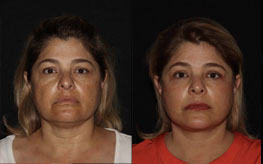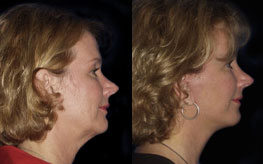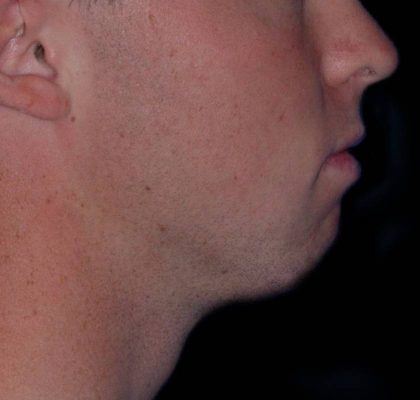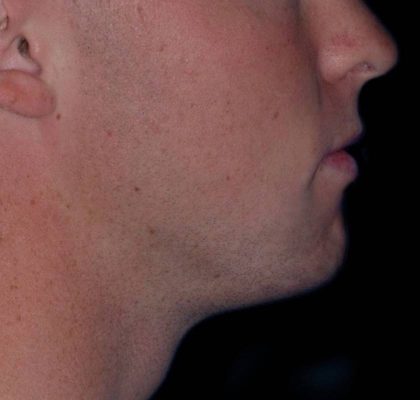Chin Reshaping For Men
Conveniently located to serve the areas of San Diego, CA

The appearance of your face is determined by three components: skin, soft tissue, and facial bones. Defined facial features and natural angles that are proportionate create balance in your face and a more attractive appearance.
If the structure of your chin is disproportionate—it is recessed or projects too much—it can affect your self image. If you are bothered by your chin, whether it is too small or too large, chin reshaping may benefit you.
For more information about our chin reshaping procedure, please contact us online or call us at 888-463-9532. We look forward to helping you look your best.
Contents
Before and After Photos
Understanding the Chin Reshaping Procedure
Chin surgery, also known as mentoplasty, is a surgical procedure to reshape the chin either by enhancement with an implant or reduction surgery on the bone. Many times a plastic surgeon may recommend chin surgery to a patient having nose surgery in order to achieve facial proportion, as the size of the chin may magnify or minimize the perceived size of the nose. Chin surgery helps provide a harmonious balance to your facial features so that you feel better about the way you look.
Chin implants can increase the size and projection of a chin that does not project in proportion with the forehead and mid-face. A small or recessed chin can also be described as one that seems to disappear into the neck of an individual of normal weight, rather than appearing as a distinct facial feature. Chin implants are specially formed solid materials designed to enhance or build up the chin.
Chin reduction can decrease the projection of the chin. In women, especially, a jaw that is too strong can be unattractive or too masculine. This procedure helps the face look more balanced, delicate, and feminine.
Before You Decide…
The Consultation
To ensure the most natural looking results, it’s imperative for a surgeon to recommend the procedure which most appropriately matches the patient’s needs and to offer realistic expectations for post-surgery outcomes. When you meet with a surgeon, you should expect a full discussion of the surgically appropriate options for your face, which is uniquely yours.
A good surgeon goes through a series of examinations and observations that are individual and dependent upon your specific situation and goals, but also factor in the surgeon’s expertise, training and experience.
The success and safety of your procedure depends very much on your complete candidness during your consultation. You’ll be asked a number of questions about your health, desires and lifestyle.
Be prepared to discuss:
- Why you want the surgery, your expectations and desired outcome
- Medical conditions, drug allergies and medical treatments
- Use of current medications, vitamins, herbal supplements, alcohol, tobacco and drugs
- Previous surgeries
We may also:
- Examine and measure your face
- Take digital photographs for computer imaging
- Discuss your options and recommend a course of reshaping your chin
- Discuss likely outcomes of chin surgery and any risks or potential complications
- Discuss the anesthesia options available
Questions to Ask
- Were you trained specifically in the field of plastic surgery?
- How many years of plastic surgery training have you had?
- Do you have hospital privileges to perform this procedure?
- Is the office-based surgical facility accredited by a nationally- or state recognized accrediting agency?
- What procedure is recommended for me?
- Am I a good candidate for this procedure?
- How many procedures of this type have you performed?
- Where and how will you perform my procedure?
- What surgical technique is recommended for me?
- How long of a recovery period can I expect, and what kind of help will I need during my recovery?
- What are the risks and complications associated with my procedure?
- How are complications handled?
- What are my options if I am dissatisfied with the cosmetic outcome of my cheek surgery?
- Do you have before-and-after photos I can look at for this procedure and what results are reasonable for me?
Who is a good candidate?
Chin surgery is best performed on people who have reached physical maturity, which generally occurs in late adolescence.
This procedure is a good option for you if:
- You are physically healthy
- You don’t smoke
- You have a positive outlook and specific goals in mind for improvement of facial contours
Because every case is unique, the only way to accurately determine which procedure is best for you is to consult with Dr. Alexander and Dr. Kaplan.
What does it cost?
A quote will be provided to you after your consult with Dr. Alexander and Dr. Kaplan. Cost is always a consideration in elective surgery, but remember that the surgeon’s experience and your comfort with him or her are just as important as the final cost of the surgery. We offer patient financing plans, so be sure to ask.
Costs include:
- Surgeon’s fee
- Operating room and supplies
- Anesthesia fees
- Prescriptions for medication
- Post-surgery garments, and
- Medical tests
Most health insurance plans will not cover chin surgery, related complications or another surgery to revise the appearance of your face. You must carefully review your health insurance policy.
To learn more about our partner in payment plans, please visit CareCredit.
The Chin Reshaping Procedure
Preparing for the Procedure
Prior to surgery, we will have you:
- Take certain medications or adjust your current medications
- Avoid taking aspirin, anti-inflammatory drugs and herbal supplements as they can increase bleeding
- Stop smoking well in advance of surgery
During a preoperative appointment, usually 1-2 weeks before surgery, we will:
- Get lab testing or a medical evaluation
- Tell you what to do on the night before and morning of surgery
- Discuss the use of anesthesia during your procedure
- Explain post-operative care and follow-up, and what help you will need after the procedure
Anesthesia
Medications are administered for your comfort during the surgical procedure. The choices include local anesthesia, intravenous sedation and general anesthesia. We will recommend the best choice for you based on your personality, your desires, and the complexity of your procedure.
How We Do It
A chin reshaping with an implant typically takes about 30-45 minutes depending on the individual face and other surgical variables.
There are five basic steps to chin implant surgery:
Step 1 – Marking
Dr. Alexander or Dr. Kaplan will make careful marks on your face prior to beginning the procedure.
Step 2 – The incision
Incisions for chin implants are generally made inside the mouth through the mucosa that lies over the chin bone where the implant will be placed.
Step 3 – Creating the pocket
A space is created under the soft tissue of the face and over the chin.
Step 4 – Inserting the implant
The implant is placed into the pocket and positioned. No sutures are needed because the pocket is the precise size of the implant, so it cannot move or shift.
Step 5 – Closing the incisions
Internal absorbable sutures close the incisions inside the mouth. A light, compressive dressing is placed on the chin to decrease swelling.
A chin reduction typically takes about 60 minutes depending on the individual face and other surgical variables.
There are five basic steps to chin reduction surgery:
Step 1 – Marking
Dr. Alexander or Dr. Kaplan will make careful marks on your face prior to beginning the procedure.
Step 2 – The incision
Incisions for chin reduction are generally made under the chin externally through the skin.
Step 3 – Elevating the tissue
The soft tissue and muscle over the chin are gently elevated to expose the bone.
Step 4 – Reshaping the chin
Using a motorized drill, a burr is used to file down the bone of the chin to a smaller size.
Step 5 – Closing the incisions
Sutures are used to close the muscle and the skin. A light, compressive dressing is placed on the chin to decrease swelling.
Informed Consent
Pain from chin surgery is usually minimal. Pain pills are provided, but are usually not required after a couple of days. Significant pain is extremely rare and may be the sign of a serious complication, so your physician should be notified.
The decision to have chin surgery is extremely personal and you’ll have to decide if the benefits will achieve your goals and if the risks and potential complications are acceptable. Your plastic surgeon and/or staff will explain in detail the risks associated with surgery.
We will explain in detail the risks associated with surgery. You will be asked to sign consent forms to ensure that you fully understand the procedure you will undergo and any risks and potential complications.
Some of the risks include:
- Unfavorable scarring
- Bleeding (hematoma)
- Infection
- Poor wound healing
- Asymmetry
- Change in skin sensation (numbness)
- Pain, which may persist
- Damage to deeper structures such as nerves, blood vessels, muscles, and lungs can occur and may be temporary or permanent
- Allergies to tape, suture materials and glues, blood products, topical preparations or injected agents
- Excessive scar tissue formation
- Firmness around the chin implant
- Shifting of implants and pressure on surrounding structures
- Skin contour irregularities
- Skin discoloration and swelling
- Skin sensitivity
- Possibility of revisional surgery
- Anesthesia risks
Important Terms to Know
Anesthesia—General: The patient is asleep, requiring that the airway be protected, either by a standard breathing tube, or by a laryngeal mask (LMA), an inflatable mask that goes in the back of the throat but doesn’t go down the trachea. Through the airway, an anesthesiologist gives gases to put the patient asleep. Drugs may also be given through the IV.
Anesthesia—Local: The surgical area is numbed up with an injection, but the patient is awake. Sometimes a patient will be given an oral medication, like Valium, to help with relaxation.
Anesthesia— Sedation (Twilight): The patient is made sleepy with medications given through an IV. The level of sedation can be adjusted, from barely sleepy to very sleepy. Sometimes sedation is given by the surgeon, but most of the time it is administered by an M.D. anesthesiologist.
Biocompatible Materials: Synthetic or natural material used in facial implants and designed to function along with living tissue.
External Incisions: Surgical incisions made on the surface of your skin.
Deviated Septum: Cartilage that separates the nostrils is misaligned which may cause partial nasal airway obstruction.
Intraoral Incisions: Surgical incisions made inside the mouth.
Mentoplasty: Surgery of the chin.
Recovery
Be sure to arrange for someone to drive you to and from surgery and to stay with you for at least the first night following surgery.
When your procedure is finished, bandages will be applied to keep the surgical site clean and to support the chin during initial healing. There may be an itchy feeling under bandages. It is essential that bandages remain intact and are not removed, for any reason.
You will be given specific instructions that include:
- how to care for the surgical site
- medications to apply or take orally to aid healing and reduce the potential for infection
- specific concerns to look for at the surgical site or in overall health
- when to return to the office
The Specifics
We will see you the day after surgery, then on the 3rd day to remove your bandage. Skin sutures need to be removed by the 5th day. At one week you can resume normal activities. At 10 days you can begin light exercise, and at four weeks there are no restrictions.
Following your doctor’s instructions regarding medications and other post-operative measures is key to a quick recovery. Herbal medications are available to reduce swelling, bruising, and to speed your recovery.
It is important that the surgical incisions are not subjected to excessive force, abrasion, or motion during the time of healing. Avoid wearing any clothing that must go over your head.
Results
While the initial outcome of chin surgery is noticeable almost immediately, it will be obscured by visible swelling. Often patients with chin implants can feel that the implants are too large. Patients who have had chin reduction may feel the chin is not small enough. It may take several months for swelling to fully dissipate. In addition, facial movements may be temporarily restricted or impaired. These are common conditions. There is usually little bruising.
In general our patients are very pleased with their chin surgery. The practice of medicine and surgery is not an exact science. Although good results are expected, there is no guarantee. Small revisions are occasionally necessary.









